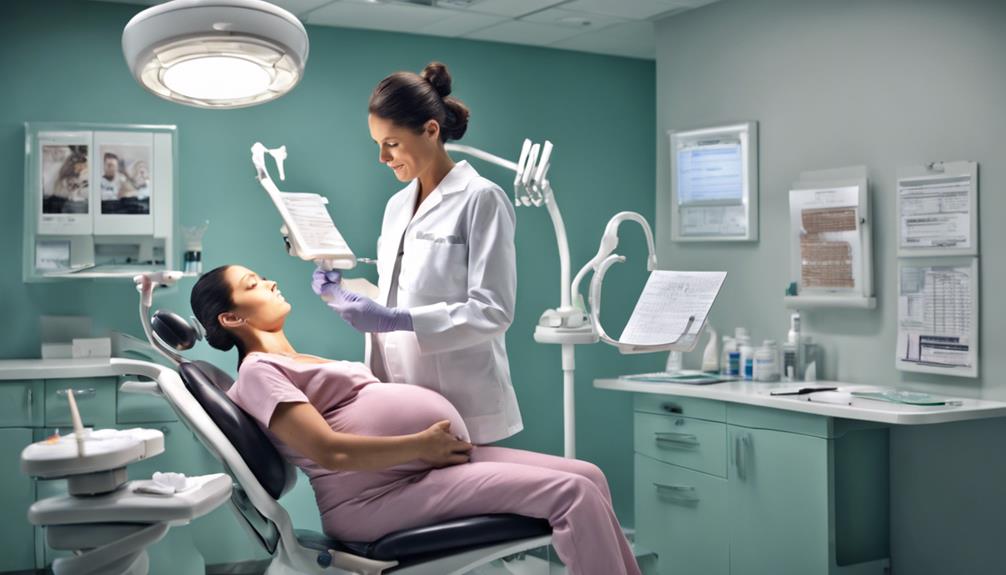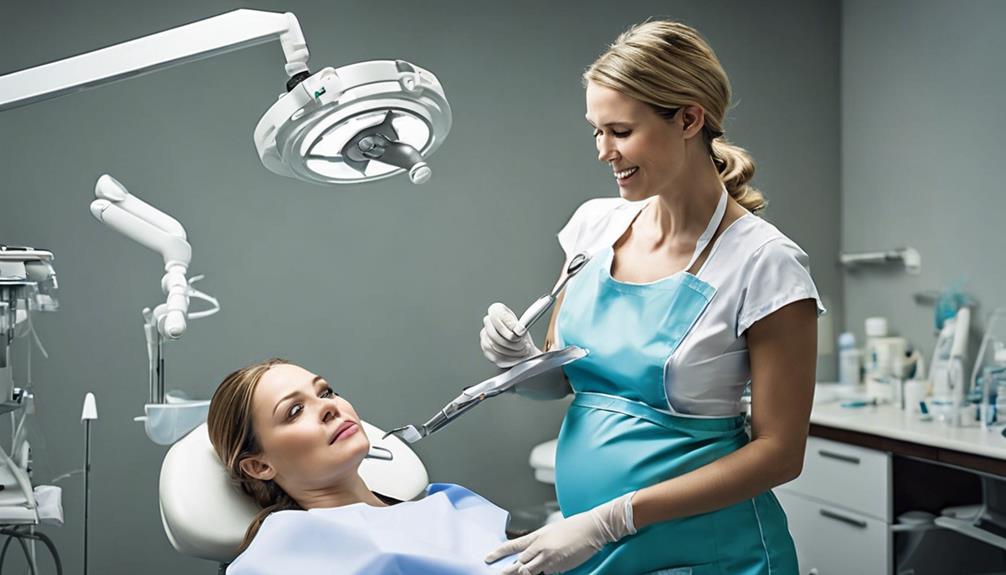First Trimester
Using Flonase Safely While Pregnant in the First Trimester
Wondering about the safety of using Flonase during the first trimester of pregnancy? Dive into the complexities and considerations for a well-informed decision.

When assessing the safety of using Flonase in the initial three months of pregnancy, it’s essential to carefully tackle the potential challenges involved.
While the decision to use Flonase may be necessary for managing severe allergies, the implications for the developing fetus require careful evaluation.
Understanding the nuances of this situation and the specific considerations involved can greatly impact the well-being of both the mother and the baby.
Let's explore how to approach this delicate balance and prioritize the health of both individuals.
Key Takeaways
- Flonase classified as FDA category C in pregnancy.
- Consult healthcare provider for personalized advice.
- Consider benefits versus potential harm.
- Opt for safe alternatives like saline spray or antihistamines.
Potential Risks of Flonase in Pregnancy
In pregnancy, potential risks associated with using Flonase are carefully considered due to its FDA pregnancy category C classification, indicating the need for weighing benefits against potential harm.
While studies haven't shown any known risks linked to Flonase use during pregnancy, especially in the first trimester, the limited research available emphasizes its overall safety for expectant mothers. Healthcare providers commonly recommend Flonase to pregnant women because of its low systemic absorption and favorable safety profile.
Despite its FDA classification suggesting potential risks, Flonase is often deemed acceptable if the benefits outweigh the potential harm. It's essential for pregnant individuals to consult their healthcare providers for personalized advice on using Flonase safely during the first trimester. This thorough evaluation guarantees that any decision regarding Flonase use in pregnancy is made with full awareness of the risks and benefits, ultimately prioritizing the well-being of both the mother and the developing fetus.
Safety Guidelines for Flonase Use

When considering the safe use of Flonase during pregnancy, healthcare providers typically advise pregnant individuals to adhere to specific safety guidelines. Flonase is classified as FDA pregnancy category C, indicating potential risks but may be used if the benefits outweigh the risks. Limited systemic absorption of Flonase minimizes exposure to the fetus during pregnancy, making it a viable option for managing severe allergy symptoms in the first trimester. It is important to stick to the recommended dose limit of 200 micrograms per day when using Flonase during pregnancy to guarantee safety for both the pregnant individual and the baby. Consulting a healthcare provider for personalized advice on the safe use of Flonase in the first trimester is highly recommended to address individual concerns and ensure the best course of action.
| Safety Guidelines for Flonase Use | |
|---|---|
| FDA Category | C |
| Recommended Dose Limit | 200 mcg/day |
| Systemic Absorption | Low |
| Consultation | Recommended |
When to Consult a Healthcare Provider
Confer with a healthcare provider prior to initiating or continuing Flonase during the first trimester of pregnancy. When to Consult a Healthcare Provider:
- Severe Allergy Symptoms: If you're experiencing severe allergy symptoms that may necessitate the use of Flonase during pregnancy, it's important to consult a healthcare provider. They can provide guidance on the safest course of action for managing your symptoms while considering the well-being of both you and your baby.
- Weigh Risks and Benefits: Healthcare provider guidance is essential to weigh the risks and benefits of using Flonase in the first trimester. They can help you make an informed decision by considering your individual situation and the potential impact on your pregnancy.
- Discuss Any Concerns: Don't hesitate to discuss any concerns about Flonase safety and its potential effects on the fetus with your healthcare provider. Open communication will make sure that you receive the best possible care and monitoring during this critical time.
Alternatives to Flonase in Pregnancy

Exploring safe alternatives for Flonase in pregnancy offers effective ways to manage allergy symptoms without resorting to medication. Here are some evidence-based options to explore:
| Alternatives | Description |
|---|---|
| Saline Nasal Spray | Using a saline nasal spray can help moisturize and clear nasal passages, relieving congestion safely. |
| Neti Pot | Nasal irrigation with a Neti pot can flush out allergens and mucus, reducing nasal inflammation. |
| Category B Antihistamines | Category B antihistamines like Zyrtec or Claritin are considered safe for allergy relief during pregnancy. |
These alternatives provide practical and safe ways to manage allergy symptoms while pregnant, offering relief without the potential risks associated with Flonase. Discussing these options with a healthcare provider can help determine the best approach for your individual needs.
Managing Nasal Congestion Safely
Considering safe options for managing nasal congestion during pregnancy is important for ensuring the well-being of both the mother and the baby.
When it comes to using Flonase in the first trimester, here are some key points to keep in mind:
- Importance of Flonase: Flonase is generally considered safe for managing nasal congestion during pregnancy, including in the first trimester. Studies have shown that the systemic absorption of Flonase is low, which helps reduce potential risks to the fetus.
- Healthcare Provider Guidance: Healthcare providers may recommend Flonase for nasal congestion relief in the first trimester if the benefits outweigh the risks. It's essential to consult with a healthcare provider before starting any medication, including Flonase, during pregnancy.
- Proper Usage: Using Flonase as directed can effectively alleviate nasal congestion without a significant impact on pregnancy outcomes. Following the recommended dosage and administration instructions is crucial for ensuring safety for both the mother and the developing baby.
Can I Use Flonase Safely While Drinking Green Tea During Pregnancy?
Yes, you can use Flonase safely while drinking green tea during pregnancy. It is important to consult with your doctor before using any medication during pregnancy, including Flonase, to ensure the green tea pregnancy safety and avoid any potential risks to the baby.
Conclusion
To sum up, managing the use of Flonase during the first trimester of pregnancy is like walking a tightrope, balancing potential risks and benefits.
By following safety guidelines, consulting healthcare providers, and exploring alternative options, pregnant individuals can manage nasal congestion safely.
Just like a skilled tightrope walker, with careful steps and guidance, they can find the right balance for a healthy pregnancy.
Nancy combines her love for writing with a deep understanding of the diverse dynamics of family life. As a parent, she brings personal experience and empathy to her work, covering topics from early childhood to the teenage years. Nancy’s work is driven by the belief that every family’s story is unique, and sharing these stories can inspire and support others on their parenting journey.
First Trimester
Dental Work While Pregnant: First Trimester Precautions Guide
Open the door to safe dental care during pregnancy's first trimester with essential precautions and guidelines – safeguarding both mother and baby's well-being.

Were you aware that about 60-75% of expectant mothers suffer from gingivitis throughout their pregnancy? This prevalent dental problem is merely one of several concerns that pregnant women should be mindful of regarding dental care in the first trimester.
Hormonal changes can impact oral health immensely, and decisions about procedures during pregnancy can be vital.
Let's explore some essential precautions and guidelines to guarantee a safe dental experience for both you and your baby during this critical period.
Key Takeaways
- Prioritize essential over elective dental treatments in the first trimester.
- Communicate pregnancy status for tailored care during dental work.
- Use safe anesthetics and medications with minimal fetal risk.
- Implement X-ray safety measures to protect the developing fetus.
Safety of Dental Work in First Trimester
During the first trimester of pregnancy, it's essential to prioritize the safety of dental work by focusing on necessary treatments and avoiding elective procedures. This trimester marks a critical period of organogenesis, where the baby's major organs begin to form. Elective procedures should be postponed to guarantee the well-being of both the mother and the developing fetus. However, routine dental cleanings and exams are generally safe and important during this time to maintain oral health.
When it comes to X-rays, caution is advised in the first trimester. They should only be performed if absolutely necessary for diagnostic purposes and with proper shielding to minimize exposure. Communication between the dentist and the pregnant patient is key in this trimester. Discussing any concerns, symptoms, or changes in health can help tailor the dental treatment plan to ensure the best possible care.
Medication Concerns During Dental Procedures

When considering medication concerns during dental procedures, it's important to prioritize safety for both the expectant mother and the developing baby. Utilizing local anesthetics like lidocaine, which have minimal placental transfer, is generally considered safe during pregnancy. It's essential to confirm that anesthesia dosage is adequate for pain alleviation while keeping it minimal to reduce any potential risks to the developing baby.
In cases where infections need to be managed, safe antibiotics such as penicillin and amoxicillin are recommended options for pregnant women undergoing dental procedures. Additionally, requesting extra numbing during dental work can help enhance comfort and reduce discomfort for pregnant patients.
X-Ray Safety for Pregnant Women
Ensuring the safety of pregnant women undergoing dental X-rays involves implementing proper shielding techniques to minimize radiation exposure to the abdomen. During pregnancy, it's important to prioritize the well-being of both the mother and the developing fetus. Dental professionals use lead aprons to shield the abdominal area, reducing the risk of radiation exposure during X-rays.
The radiation dose from a routine dental X-ray is minimal, posing minimal risk to the fetus. However, due to increased susceptibility to radiation effects, additional precautions such as thyroid collars may be utilized for pregnant women. Elective dental X-rays are often postponed, especially during the first trimester when the fetus is most vulnerable.
Precautions for Dental Procedures

Implementing appropriate precautions during dental procedures in the first trimester is paramount to safeguarding the health of both the expectant mother and the developing fetus. When considering dental work during pregnancy, especially in the first trimester, it's vital to prioritize safety and minimize risks.
Here are some key precautions to take:
- Limit dental procedures to essential treatments to avoid potential risks during organogenesis.
- Inform both your obstetrician and dentist about your pregnancy status for tailored care.
- Postpone elective procedures until after the first trimester to reduce impact on fetal development.
- Take special precautions during dental work to minimize any potential risks to the developing fetus.
- Consult with your healthcare providers to determine the best course of action for dental procedures during this critical period.
Prioritizing communication and safety measures ensures the well-being of both the mother and the baby during this delicate phase.
Local Anesthetic Use in First Trimester
Utilizing local anesthetics like lidocaine in the first trimester of pregnancy is a common practice during dental procedures. Studies have shown that these anesthetics are generally safe for pregnant individuals and their babies. Ensuring the proper dosage of local anesthetics is vital in maintaining comfort and safety during dental work in the first trimester. Dentists are trained to prioritize the use of minimal yet effective amounts of local anesthesia to mitigate any potential risks associated with pregnancy. Open communication with your dentist about your pregnancy status and any concerns regarding the use of local anesthetics is essential for receiving personalized care tailored to your needs. Here is a table highlighting key points about local anesthetic use in the first trimester:
| Aspect | Importance | Recommendation |
|---|---|---|
| Proper Dosage | Vital for safety and comfort during procedures | Dentists should carefully calculate the amount used |
| Risk Minimization | Minimizing potential risks to the pregnancy | Dentists aim to use the least amount necessary |
| Communication | Essential for personalized care and reassurance | Patients should openly discuss any concerns |
Are the Precautions for Dental Work During Pregnancy Similar to Those for Safe Pedicures in the First Trimester?
Yes, the precautions for dental work during pregnancy are similar to those for safe pedicures during pregnancy in the first trimester. Both require careful consideration of potential risks and use of safe procedures and products to ensure the health and safety of the mother and baby.
Conclusion
To guarantee safety during dental work in the first trimester of pregnancy, it's important to prioritize.
Did you know that up to 64% of pregnant women experience gingivitis due to hormonal changes?
By taking necessary precautions and communicating effectively with your dentist, you can secure a smooth and comfortable experience while protecting both you and your baby's health.
Remember, your oral health is an essential part of your overall well-being during pregnancy.
Nancy combines her love for writing with a deep understanding of the diverse dynamics of family life. As a parent, she brings personal experience and empathy to her work, covering topics from early childhood to the teenage years. Nancy’s work is driven by the belief that every family’s story is unique, and sharing these stories can inspire and support others on their parenting journey.
First Trimester
Hot Bath Safety Tips for First Trimester Pregnancy
Discover crucial hot bath safety tips for first trimester pregnancy, including lesser-known considerations that can significantly impact maternal and fetal well-being.

Navigating through the initial three months of pregnancy, it’s crucial to prioritize the safety of taking hot baths. It’s important to meticulously check the temperature of the water and make sure that our body’s core temperature stays within safe boundaries.
But, what about other often-overlooked aspects that could impact our well-being and that of our growing baby? Let's explore additional safety tips that can further enhance our bath time routines during this sensitive period.
Key Takeaways
- Keep bath water below 102°F to safeguard the fetus in the first trimester.
- Use non-slip mats for stability to prevent falls during pregnancy.
- Avoid harsh soaps to maintain vaginal pH balance and skin health.
- Consult a healthcare provider before bathing post water break to prevent infections.
Importance of Bath Temperature Control
Maintaining the bath water temperature below 102 degrees Fahrenheit is essential during the first trimester of pregnancy to protect the developing fetus from potential harm. In these early stages, the risk of neural tube defects increases with elevated core body temperature, making precise bath temperature control important. Using a thermometer to monitor and adjust the water temperature is a simple yet critical safety measure to safeguard the well-being of both the mother and the baby.
Hot baths can lead to overheating, which poses a risk to the developing fetus. Hence, it's recommended to opt for warm, not hot, water and limit the time spent in the bath to prevent any adverse effects on the pregnancy. By being mindful of the water temperature and following these safety tips, expectant mothers can guarantee a relaxing bath experience without compromising the health of the baby during the delicate first trimester.
Risks of Hot Baths in Pregnancy

Hot baths during pregnancy, particularly in the first trimester, pose significant risks to the developing fetus. The elevated core body temperature caused by hot tubs and high temperatures can increase the likelihood of neural tube defects and other birth defects in the baby. Exposure to such heat during the critical early weeks can impact the development of the spine and central nervous system, potentially doubling the risk of neural tube defects. To minimize these risks, it is important to avoid hot tub use with temperatures exceeding 101 degrees Fahrenheit in the first trimester. Here is a table summarizing the risks associated with hot baths during pregnancy:
| Risk Factor | Consequence |
|---|---|
| Neural Tube Defects | Increased risk of spinal cord and brain abnormalities |
| Elevated Core Body Temperature | Potential birth defects due to overheating |
| Central Nervous System Impact | Developmental issues in the baby's brain and spine |
| High Temperatures Exposure | Doubled risk of neural tube defects during critical weeks |
Taking precautions and avoiding excessive heat exposure is important for a healthy pregnancy.
Benefits of Non-Slip Mats
To enhance safety and prevent falls in the bath for pregnant women, utilizing non-slip mats is essential. These mats play an important role in maintaining stability, especially with the balance changes that often accompany pregnancy.
Here are three key benefits of using non-slip mats:
- Reduced Risk of Injuries: Non-slip mats in baths greatly decrease the chances of accidents caused by slippery surfaces, offering expectant mothers a secure footing and peace of mind.
- Enhanced Stability: Pregnant women may face mobility challenges, making it important to have a stable surface in the bath. Non-slip mats provide the necessary support to prevent slips and falls.
- Improved Safety: By incorporating non-slip mats, pregnant individuals can create a safer bathing environment, minimizing the risk of accidents and promoting a comfortable experience during a time of physical changes.
Utilizing non-slip mats is a simple yet effective way to enhance bath safety for expectant mothers, ensuring a worry-free bathing routine.
Caution With Harsh Soaps

Being mindful of the soap you use is important during pregnancy to protect the delicate balance of the vagina's natural pH. When taking hot baths, it's vital to avoid harsh, fragranced bath products that can disrupt this balance and potentially lead to urinary tract infections. Opt for gentle, fragrance-free soaps to prevent irritation and maintain the health of your skin.
Harsh soaps have the potential to strip away essential oils, causing dryness and discomfort, particularly in the sensitive areas of a pregnant woman's body. Choosing mild, hypoallergenic soaps is the safest option to make sure your skin remains healthy and free from adverse reactions.
During pregnancy, it's best to steer clear of soaps containing strong chemicals or perfumes that may be too harsh for your skin. By using gentle soaps, you can enjoy your hot baths safely without compromising the well-being of your skin or intimate areas.
Precautions After Water Breaks
After water breaks during pregnancy, it's imperative to refrain from taking hot baths to safeguard against potential infections and complications, particularly for the baby's health. The high core body temperature that hot baths can induce poses risks that could harm the baby. Consult your healthcare provider before considering taking a bath if your water has broken to guarantee the safety of both you and your baby.
Opting for cool showers instead of hot baths can help regulate your body temperature and reduce the risk of any harm to the baby. Keep the water temperature below 100°F to further minimize any potential dangers.
- Avoid hot tubs or jacuzzis as the high temperature can be harmful.
- Be cautious about the temperature of the water when taking a bath.
- Prioritize your healthcare provider's guidance and follow their recommendations diligently.
Are Hot Baths Safe During the First Trimester of Pregnancy?
Hot baths are generally safe during the first trimester of pregnancy, but it’s important to be cautious. Soaking for too long in hot water can raise body temperature, which may be harmful to the baby. It’s similar to the importance of safe honey consumption during pregnancy. Always consult with a healthcare professional for guidance.
Conclusion
As we navigate the delicate journey of pregnancy, let's remember that just like a gentle stream flowing with grace, our bodies require careful attention and nurturing.
By following these hot bath safety tips, we can guarantee a smooth and tranquil passage for both ourselves and our little ones.
Let's embrace the warmth of self-care while safeguarding the precious life within us, like a guardian angel watching over a blossoming flower.
Nancy combines her love for writing with a deep understanding of the diverse dynamics of family life. As a parent, she brings personal experience and empathy to her work, covering topics from early childhood to the teenage years. Nancy’s work is driven by the belief that every family’s story is unique, and sharing these stories can inspire and support others on their parenting journey.
First Trimester
Safely Using Promethazine in First Trimester of Pregnancy
Bridging the gap between safety and uncertainty, exploring the use of Promethazine in early pregnancy raises intriguing questions.

Embarking on the journey of using Promethazine in early pregnancy is akin to navigating through unknown territory with utmost caution. The discussions about its safety and effectiveness in these crucial initial stages are critically important.
However, the debate lingers on, prompting a closer examination of the intricate balance between potential benefits and inherent risks associated with its use.
Stay tuned as we unravel the complexities and nuances surrounding the safe administration of Promethazine in the first trimester of pregnancy.
Key Takeaways
- Limited first-trimester data; individualized risk assessment essential.
- Promethazine effective in reducing first-trimester nausea severity.
- Monitor for adverse effects due to fetal mortality risks.
- Follow prescribed dosage guidelines closely for maternal-fetal safety.
Safety Considerations for Promethazine Use
When considering the safety of promethazine use in the first trimester of pregnancy, healthcare providers emphasize the need for careful evaluation due to the limited data available on its effects during this critical period. The decision to use promethazine during this time involves a complex balance between its potential benefits and the uncertainties surrounding its impact on fetal development.
While no definitive evidence points to major risks, the lack of thorough studies underscores the importance of individualized risk assessment in consultation with a healthcare provider.
Given the unique circumstances of each pregnancy, a thorough discussion regarding the necessity and potential risks of promethazine use is essential, taking into account the individual's medical history and current condition. Monitoring for any adverse effects or changes in fetal development should be an integral part of the care plan when considering the use of promethazine in the first trimester. By carefully weighing these factors and maintaining open communication with healthcare professionals, individuals can make informed decisions regarding the safety of promethazine during early pregnancy.
Efficacy of Promethazine for Nausea

Promethazine demonstrates notable efficacy in reducing nausea and vomiting for pregnant women, particularly during the first trimester. Studies have consistently shown that promethazine is a valuable medication for managing morning sickness symptoms early in pregnancy. Its ability to alleviate nausea in the initial stages of pregnancy makes it a favorable treatment option for pregnant individuals experiencing morning sickness. Clinical evidence supports the use of promethazine as an effective remedy for nausea in the first trimester, highlighting its potential benefits for pregnant women.
| Efficacy of Promethazine for Nausea | ||
|---|---|---|
| Study Design | Findings | Conclusion |
| Randomized controlled trial | Promethazine notably reduced nausea scores compared to a placebo. | Promethazine is an effective option for managing nausea in pregnant women. |
| Prospective cohort study | Pregnant individuals reported decreased vomiting episodes with promethazine use. | Promethazine shows promise in reducing vomiting episodes during pregnancy. |
| Meta-analysis | Promethazine was associated with a notable decrease in nausea severity. | The meta-analysis supports promethazine's efficacy in addressing nausea during pregnancy. |
Risks and Benefits in Pregnancy
What're the risks and benefits associated with using promethazine during pregnancy, particularly in the first trimester?
- Risks:
- Fetal mortality risks based on animal studies.
- Limited human data available for evaluating specific risks in the first trimester.
- Monitoring for potential adverse effects on the fetus is recommended.
Promethazine, classified as a category C pregnancy drug, presents a complex scenario where healthcare providers play a vital role. While the medication may offer benefits in managing symptoms like nausea and vomiting, the potential risks to the fetus must be carefully considered.
Consulting with a healthcare provider becomes essential to navigate this delicate balance. The decision to use promethazine during the first trimester should be a well-informed one, weighing the potential benefits against the known and potential risks. In this context, close monitoring and open communication with a healthcare provider can help ensure the best possible outcome for both the mother and the developing fetus.
Dosage Guidelines for Expectant Mothers

For expectant mothers, following recommended dosage guidelines for promethazine in the first trimester of pregnancy is important for minimizing potential risks to the developing fetus. The typical dosage of promethazine during this period ranges from 12.5 to 25 mg every 4-6 hours as needed for managing nausea and vomiting. It is essential to adhere to the prescribed dosage and frequency to guarantee the safety of both the mother and the baby. Dosage adjustments should only be made under the supervision of a healthcare provider based on individual response and symptom severity. Keeping the dosage at the lowest effective level for the shortest duration possible is crucial in pregnancy. Below is a table summarizing the dosage guidelines:
| Dosage Guidelines | Frequency |
|---|---|
| 12.5-25 mg | Every 4-6 hours |
| Individualized adjustments | Under medical guidance |
| Lowest effective dose | Shortest duration |
Consulting with a healthcare provider is essential for personalized dosing advice and to address any concerns or potential side effects associated with promethazine use in the first trimester.
Consultation With Healthcare Providers
Consulting healthcare providers before initiating promethazine use in the first trimester of pregnancy is essential for ensuring the safety and well-being of both the mother and the developing fetus. Healthcare providers play a critical role in evaluating individual risks and benefits associated with using promethazine during this critical stage. Here are three key reasons why consulting with healthcare providers is paramount in early pregnancy:
- Personalized Evaluation: Healthcare providers can evaluate the specific circumstances of each expectant mother to determine the appropriateness of promethazine use.
- Guidance and Support: Discussing any concerns or questions with a healthcare provider can offer valuable guidance and support in navigating the safe use of promethazine during early pregnancy.
- Dosage and Timing: Healthcare professionals are equipped to provide tailored advice on the correct dosage and timing of promethazine intake in the first trimester, ensuring the best safety for both the mother and the fetus.
Seeking medical advice before starting or continuing promethazine in the first trimester is critical to safeguard maternal and fetal health.
Conclusion
To sum up, the use of Promethazine in the first trimester of pregnancy requires careful consideration and consultation with healthcare providers. Like a guiding light in the storm, Promethazine can offer relief for various conditions while ensuring the safety of both mother and baby.
By weighing the risks and benefits, following dosage guidelines, and seeking medical guidance, expectant mothers can confidently sail through their pregnancy journey with peace of mind. Trust in the guidance of healthcare experts to steer you towards a safe and healthy pregnancy.
Nancy combines her love for writing with a deep understanding of the diverse dynamics of family life. As a parent, she brings personal experience and empathy to her work, covering topics from early childhood to the teenage years. Nancy’s work is driven by the belief that every family’s story is unique, and sharing these stories can inspire and support others on their parenting journey.
-

 Third Trimester3 weeks ago
Third Trimester3 weeks agoSafe Third Trimester Exercise Guide for Moms-to-Be
-

 Breastfeeding/Formula Feeding1 week ago
Breastfeeding/Formula Feeding1 week agoOvercoming Formula Feeding Guilt: 10 Ways to Feel Empowered
-

 Breastfeeding/Formula Feeding2 months ago
Breastfeeding/Formula Feeding2 months agoDairy-Free Breastfeeding Diet: A Comprehensive Guide
-

 Third Trimester2 months ago
Third Trimester2 months agoWhat Causes Low Platelets in Pregnancy During the Third Trimester?
-

 Newborn Care3 weeks ago
Newborn Care3 weeks agoEssential Newborn Care: A How-To Guide for Parents
-

 Third Trimester2 months ago
Third Trimester2 months agoSigns of Baby Distress in Third Trimester: What to Watch For
-

 First Trimester6 days ago
First Trimester6 days agoDramamine Use in Pregnancy: First Trimester Guide
-

 Third Trimester2 months ago
Third Trimester2 months agoMonitoring Fetal Heart Rate in the Third Trimester: A How-To Guide










